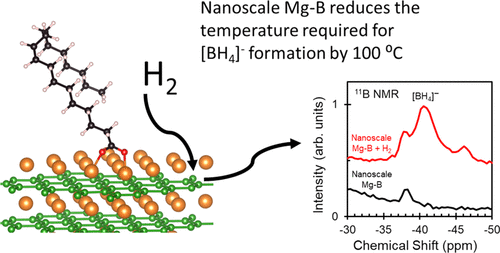当前位置:
X-MOL 学术
›
J. Phys. Chem. C
›
论文详情
Our official English website, www.x-mol.net, welcomes your
feedback! (Note: you will need to create a separate account there.)
Nanoscale Mg–B via Surfactant Ball Milling of MgB2: Morphology, Composition, and Improved Hydrogen Storage Properties
The Journal of Physical Chemistry C ( IF 3.3 ) Pub Date : 2020-09-04 , DOI: 10.1021/acs.jpcc.0c05142 Y.-S. Liu 1 , K. G. Ray 2 , M. Jørgensen 3 , T. M. Mattox 4 , D. F. Cowgill 5 , H. V. Eshelman 2 , A. M. Sawvel 2 , J. L. Snider 5 , W. York 5 , P. Wijeratne 5 , A. L. Pham 4 , H. Gunda 6 , S. Li 2 , T. W. Heo 2 , S. Kang 2 , T. R. Jensen 3 , V. Stavila 5 , B. C. Wood 2 , L. E. Klebanoff 5
The Journal of Physical Chemistry C ( IF 3.3 ) Pub Date : 2020-09-04 , DOI: 10.1021/acs.jpcc.0c05142 Y.-S. Liu 1 , K. G. Ray 2 , M. Jørgensen 3 , T. M. Mattox 4 , D. F. Cowgill 5 , H. V. Eshelman 2 , A. M. Sawvel 2 , J. L. Snider 5 , W. York 5 , P. Wijeratne 5 , A. L. Pham 4 , H. Gunda 6 , S. Li 2 , T. W. Heo 2 , S. Kang 2 , T. R. Jensen 3 , V. Stavila 5 , B. C. Wood 2 , L. E. Klebanoff 5
Affiliation

|
Metal borides have attracted the attention of researchers due to their useful physical properties and unique ability to form high hydrogen-capacity metal borohydrides. We demonstrate improved hydrogen storage properties of a nanoscale Mg–B material made by surfactant ball milling MgB2 in a mixture of heptane, oleic acid, and oleylamine. Transmission electron microscopy data show that Mg–B nanoplatelets are produced with sizes ranging from 5 to 50 nm, which agglomerate upon ethanol washing to produce an agglomerated nanoscale Mg–B material of micron-sized particles with some surfactant still remaining. X-ray diffraction measurements reveal a two-component material where 32% of the solid is a strained crystalline solid maintaining the hexagonal structure with the remainder being amorphous. Fourier transform infrared shows that the oleate binds in a “bridge-bonding” fashion preferentially to magnesium rather than boron, which is confirmed by density functional theory calculations. The Mg–B nanoscale material is deficient in boron relative to bulk MgB2 with a Mg–B ratio of ∼1:0.75. The nanoscale MgB0.75 material has a disrupted B–B ring network as indicated by X-ray absorption measurements. Hydrogenation experiments at 700 bar and 280 °C show that it partially hydrogenates at temperatures 100 °C below the threshold for bulk MgB2 hydrogenation. In addition, upon heating to 200 °C, the H–H bond-breaking ability increases ∼10-fold according to hydrogen–deuterium exchange experiments due to desorption of oleate at the surface. This behavior would make the nanoscale Mg–B material useful as an additive where rapid H–H bond breaking is needed.
中文翻译:

通过表面活性剂球磨MgB 2来制备纳米级Mg-B :形貌,组成和改善的储氢性能
金属硼化物因其有用的物理特性和形成高氢容量金属硼氢化物的独特能力而吸引了研究人员的注意。我们证明了通过表面活性剂球磨MgB 2制成的纳米级Mg-B材料的储氢性能得到了改善在庚烷,油酸和油胺的混合物中 透射电子显微镜数据显示,Mg-B纳米片的尺寸为5至50 nm,在乙醇洗涤后会发生团聚,从而生成微米级颗粒的团聚的纳米级Mg-B材料,并残留一些表面活性剂。X射线衍射测量揭示了一种双组分材料,其中32%的固体是应变结晶固体,保持六边形结构,其余部分为非晶态。傅里叶变换红外表明,油酸酯以“桥键”方式优先结合镁而不是硼,这已通过密度泛函理论计算得到证实。与块状MgB 2相比,Mg–B纳米级材料的硼缺乏。Mg-B比约为1:0.75。X射线吸收测量表明,纳米级MgB 0.75材料具有破裂的B–B环网。在700 bar和280°C的条件下进行的氢化实验表明,它在低于本体MgB 2氢化阈值100°C的温度下部分氢化。此外,根据氢-氘交换实验,由于表面上油酸盐的解吸,加热至200°C时,H–H键的断裂能力增加了约10倍。这种行为将使纳米级Mg-B材料可用作需要快速断开H-H键的添加剂。
更新日期:2020-10-02
中文翻译:

通过表面活性剂球磨MgB 2来制备纳米级Mg-B :形貌,组成和改善的储氢性能
金属硼化物因其有用的物理特性和形成高氢容量金属硼氢化物的独特能力而吸引了研究人员的注意。我们证明了通过表面活性剂球磨MgB 2制成的纳米级Mg-B材料的储氢性能得到了改善在庚烷,油酸和油胺的混合物中 透射电子显微镜数据显示,Mg-B纳米片的尺寸为5至50 nm,在乙醇洗涤后会发生团聚,从而生成微米级颗粒的团聚的纳米级Mg-B材料,并残留一些表面活性剂。X射线衍射测量揭示了一种双组分材料,其中32%的固体是应变结晶固体,保持六边形结构,其余部分为非晶态。傅里叶变换红外表明,油酸酯以“桥键”方式优先结合镁而不是硼,这已通过密度泛函理论计算得到证实。与块状MgB 2相比,Mg–B纳米级材料的硼缺乏。Mg-B比约为1:0.75。X射线吸收测量表明,纳米级MgB 0.75材料具有破裂的B–B环网。在700 bar和280°C的条件下进行的氢化实验表明,它在低于本体MgB 2氢化阈值100°C的温度下部分氢化。此外,根据氢-氘交换实验,由于表面上油酸盐的解吸,加热至200°C时,H–H键的断裂能力增加了约10倍。这种行为将使纳米级Mg-B材料可用作需要快速断开H-H键的添加剂。











































 京公网安备 11010802027423号
京公网安备 11010802027423号